

|
Back to |
| The Front Page |
| News & Features |

|
National Croquet Center shines in first major pre-season events
|
||||||
|
story and photos by Bob Alman design and layout by Reuben Edwards Posted October 31, 2002
|
||||||
|
||||||
The season was over when the clubhouse opened in May with most of the accouterments in place but no license for the café and bar service. The first members made do over the summer, with "pot-luck" parties on Thursdays and bring-your-own liquids. All of that changed in the first week in October, when Café Croquet opened and the liquor license arrived, just in time for the first major events of the preseason.
The annual Solomon Trophy matches were a low-key affair, with only six men on each team competing over five days. The average world ranking of the world champion Brits was 29; the average for the less experienced Americans was 102. Everyone’s expectations for the Americans were low - except for, as it turns out, the team members themselves. The American team turned in their best ever performance in the 12-year history of the event. For the first time, they entered the final day of the test matches still alive, losing the test series on that day 13-8.
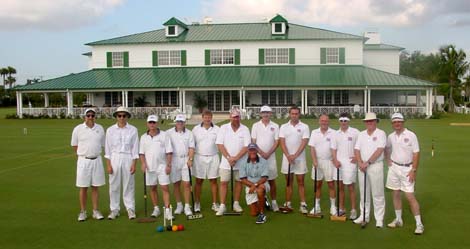
|
| With Americans on the left, Brits on the right, and Director of Croquet Archie Peck in the middle, the Solomon Trophy matches begin with this official portrait. |
The ever-gracious British team captain, David Openshaw, noted during the closing ceremonies of the Solomon Trophy a higher level of skill, discipline and maturity in the American team than he had ever seen. And he should know. At the age of 56, he has played on more international test teams for the British than any other competitor.
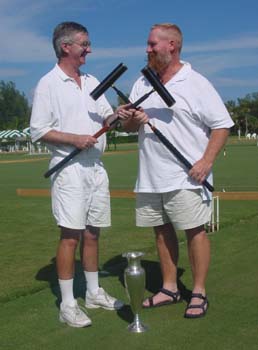
|
| Captains of the two teams square off: David Openshaw for Britain on the left, Jerry Stark of California on the right. |
The postcript to the Solomon was even more satisfying to the Americans: The American-rules Presidents Cup was an American stampede: the yanks lost only one of the 15 singles and doubles matches. Openshaw’s closing comments were equally gracious, beginning, ‘Unaccustomed as I am to presiding over the defeat of a British team."
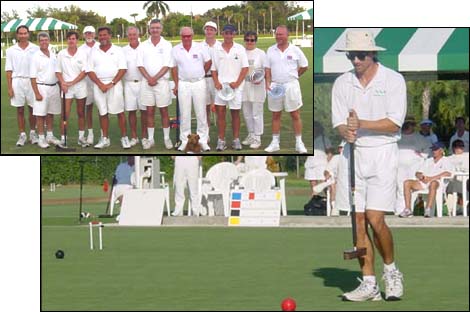
|
| Jeff Soo, with his low-key, deliberate style, was the hero of the preseason events, leading his all-North Carolina team to victory in the Presidents Cup, then winning both singles and doubles in the USCA National Championship. insert: Six victorious North Carolinians (left) pose with the Brits off the East Veranda after the American victory in the President Cup. |
But the British were still the overall victors in the week-long competition, and few would expect their supremacy in the sport to be seriously challenged by the Americans in the near future - that is, in the MacRoberton Shield matches to be held at the National Croquet Center in October and November of 2003.
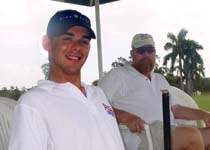
|
| Youngest competitor in the Solomon was 23-year-old Matthew Burrow of Jersey, fresh from beating Stephen Mulliner for the European championship. |
The MacRobertson Shield is the sport’s main event, held once every three years, and it comes to America for the first time in 2003. The four competing teams are from Britain, New Zealand, USA, and Australia, and they rank in exactly that order.
In the Shield games of 2000 in New Zealand, the last day of the critical matches was a spectacular cliffhanger. Both the British/Kiwi test and the American/Ozzie test came down the final game in the final match. It’s fair to say that the Brits were shocked and surprised by the performance of the Kiwis, and the Americans were delighted (and perhaps somewhat surprised) to have knocked off the Australians, however narrowly, for the first time - and thus ascend to third place in the ranking of croquet playing nations.
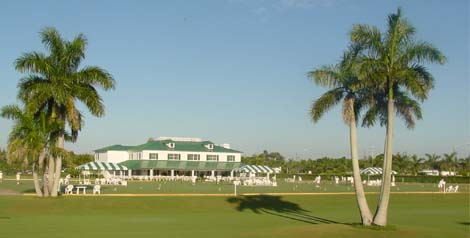
|
| The courts are set up early in the morning before play begins on the world’s largest croquet lawn. |
So expectations for the next MacRobertson, in West Palm Beach in 2003, have never been higher, with nothing less than the world order of croquet power at stake.

|
| (left) The British mascot gazes impassively upon the courts, while major donor Bill Campbell gazes equally impassively.
(right) Simon and Nicky Lacey, owners of Diplomatic Travel Ltd. of East Sussex, lunch in Café Croquet with Center staff members, settling details of the British tour they’re sending to Florida in February. |
All the games can be played at one venue - a place everyone in the croquet world wants to visit, whether as a top-ranked player at a major competition or a sightseeing snowbird. Thirty or 40 British croquet players are coming over in mid-February just to play at the National Croquet Center and see the sights of South Florida. More will come in November of 2003 to cheer on their teams and to play croquet at other South Florida venues. (It’s a travel adventure being billed as "The Palm Beach Croquet Trail.")
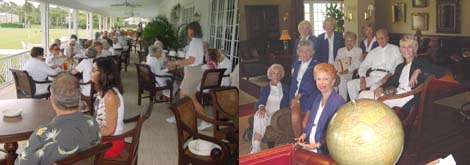
|
| (right) Local volunteers meet in the Members Lounge to plan greeting, hosting, and visitor services. With a small staff, the Center needs good volunteers for both the clubhouse and the lawns |
Why does everyone want to come here? Because there is no parallel anywhere to the scale and the intention of the National Croquet Center. Even the Brits, rulers of the sport, acknowledge this. European champ Matthew Burrow was heard telling somebody across the Atlantic in a phone call, "You’ve got to see it, there’s no place like it, anywhere." I asked captain David Openshaw for his official summation, which he gladly gave with a smile: "It’s croquet’s new Mecca."

|